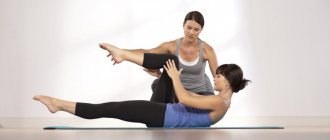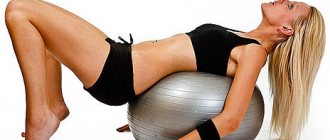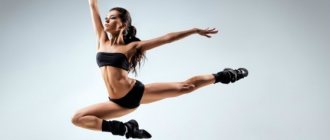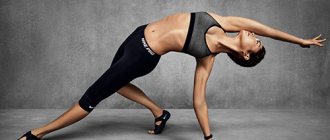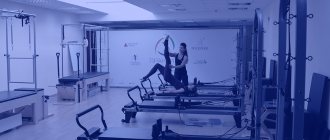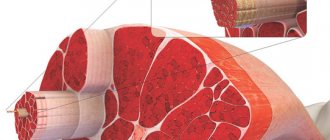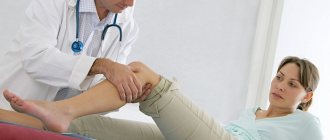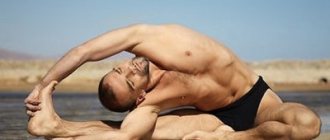Power training
Body Combat or Body Training is a type of strength training aimed at strengthening all major muscle groups.
Strength training is the fastest and most effective way to make your body sculpted and toned. Strength training is very diverse and suitable for almost everyone.
Body Combat or Body Training strengthens all major muscle groups, makes the human body fit and beautiful, develops muscular endurance, strengthens the cardiovascular system, and has a positive effect on the musculoskeletal system.
Such loads are suitable for well-physically trained people - with an average and high level of training: to relieve nervous tension and combat chronic fatigue syndrome, to prevent the consequences of a lack of movement by increasing the tone and strength of the muscles of the arms, legs, abdominals, back and strengthening the ligamentous apparatus for postural disorders, to normalize joint mobility.
Contraindications:
all general
*
, as well as decreased visual acuity.
What's better for your back?
There is no more beneficial form of fitness for the back than Pilates - a health system designed to treat diseases associated with functional disorders of the spine.
Pilates exercises:
- strengthens the back muscles;
- return the vertebrae to the physiologically correct position;
- improve blood circulation and metabolism in the intervertebral discs;
- correct posture.
Stretching, thanks to the development of spine flexibility, is also beneficial for the back. Stretching allows you to maintain a balance between tension and relaxation of the muscles that support the spinal column, make them more elastic, the vertebrae more mobile, and reduce the likelihood of lower back injuries during physical activity.
If you have back problems, you need to approach even Pilates and stretching exercises with caution. Supervision by the attending physician and sports instructor is desirable. Improper exercise technique can aggravate the situation.
Dance (classical) aerobics
Dance (classical) aerobics is a type of training in which various dance and basic aerobics steps are performed non-stop.
This type of program is an ideal way to lose extra calories.
Classic aerobics trains the cardiovascular system, develops cardio endurance, has a positive effect on the musculoskeletal system, promotes fat burning and gives you energy for the whole day!
Aerobics is great for strengthening all muscle groups, increasing the overall endurance of the body, improving the functioning of the cardiovascular and respiratory systems, and is suitable not only for healthy people, but also for those with excess body weight and poor posture.
Contraindications:
all general, as well as severe arthrosis of the joints of the lower extremities and flat feet, angina pectoris, second and third degree hypertension, heart failure, varicose veins of the lower extremities.
Yogalates
As a synthesis of two directions designed to improve the body and soul, Yogalates, or yoga Pilates, arose. This is a new word in fitness that is gaining popularity. His movements and positions, flowing into each other during the training process, are based on softness and plasticity.
The body accumulates fat under stress. Compulsive eating disorders, when a person “eats” psychological problems, also contribute to excess weight gain. Yogalates is aimed at eliminating stress.
As a result, both appearance and health improve, and performance increases. By doing yogalates, people correct their posture, become flexible, note that their immunity has increased, and they have a feeling of inner peace. Thanks to this, the natural hormonal balance is restored, diseases of a nervous and psychosomatic nature disappear, and the desire to live and create appears.
Step aerobics
Step aerobics is a type of training in which various dance and basic aerobics steps are performed non-stop using a special step platform.
The step platform increases the intensity of the workout, because... During the lesson, steps are performed with entry, both onto the platform and around it.
Step aerobics gives everything the same as classical aerobics, also providing the prevention of injuries to the knee joint, but only with the correct technique!
An excellent type of physical training, suitable for people of any fitness level. Recommended for healthy people - to prevent the consequences of lack of movement (hypodynamia and hypokinesia), strengthen the main muscle groups, improve the functioning of the cardiovascular and respiratory systems. Indicated for overweight, obesity degrees 1-2.
Contraindications
: all general, as well as severe osteochondrosis of the lumbar spine with radicular syndrome, spinal hernia, decompensated venous pathology of the lower extremities, cardiac arrhythmia, severe flat feet.
Tai-bo
Tai-bo is a type of aerobic training using elements of martial arts and martial arts.
Tai-bo is an ideal way to get rid of negativity, charge with positive emotions and a quick way to lose weight.
Tai-bo gives a slim and strong body, strong muscles of the arms, legs and abdomen, good physical fitness, high muscle endurance, develops agility, and teaches self-defense.
Another type of aerobic strength exercise, suitable for healthy trained people, 1 hour of which approximately corresponds to the effect of a 10-kilometer run. Indicated exclusively for practically healthy people to increase the adaptive capabilities of the cardiovascular system, increase muscle tone, control body weight, and for the musculoskeletal system - increase flexibility, strength, improve reaction, coordination.
Contraindications:
all general, as well as decreased visual acuity.
What's best for losing weight?
You won't be able to lose weight quickly using the Joseph Pilates method. The exercises are performed at a slow pace, there is no cardio or strength training that would contribute to weight loss. In an hour of training you can burn a maximum of 200 kcal.
Unlike Pilates, during ancient Indian practice classes the muscles are in static tension, which increases calorie consumption to 300-350 and promotes weight loss.
Holding the body in asanas engages slow muscle fibers, which activate the process of burning fat deposits. These muscles cannot be used during dynamic repetition of movements.
This type of yoga, such as Power Yoga, helps you lose weight even faster - the static load on the muscles in asanas is supplemented by cardio and strength training, the number of calories burned per hour increases to 400-500.
Yoga and Pilates are more suitable for maintaining good physical shape after losing weight. Regular exercise combined with proper nutrition and an active lifestyle will prevent you from gaining excess weight and will help keep your body in good shape.
Cycling (or spinning)
Cycling (or spinning) is a type of exercise bike program.
Energetic music and good company of cyclists are the best way to get rid of extra pounds!
Cycling gives: cardiovascular training, cardio endurance, high fat burning, strengthening leg muscles, especially the lower leg, and good spirits.
Cycling training is a unique training that has virtually no specific contraindications (with the exception of general ones), except for pregnancy and venous pathology of the lower extremities. The advantages of this method are that in the absence of a “shock” load on the spine, the abdominal muscles, pelvic floor, and legs are trained, and the activity of the autonomic nervous system is improved. Indicated for cellulite, overweight, obesity of 1-2 degrees, can be used in preparation for a planned pregnancy.
The benefits of these types of fitness
Regular stretching classes, like Pilates, have a general healing effect on the body, which manifests itself in the coming weeks. It becomes easier to perform everyday movements, because the muscles of the whole body, spine and ligaments become more flexible and elastic, and coordination improves.
Both types of fitness have a rejuvenating effect on the body - the spine becomes more flexible and gradually returns to its physiologically correct position. Day after day, pain in the joints and back decreases, and the functioning of internal organs normalizes.
Despite the fact that the exercises and principles of Pilates and stretching are different, both types of fitness contribute to the harmonious development and strengthening of all systems and functions of the body:
- improve the condition of the spine;
- increase body flexibility and joint mobility;
- increase blood circulation;
- relieve insomnia and depression;
- increase immunity;
- normalize digestive functions;
- increase performance;
- balance the hormonal system;
- relieve problems in the sexual sphere;
- help make the figure more slender and graceful.
These healing effects can be guaranteed to be obtained if you regularly and correctly perform exercises from the Pilates or stretching complex.
Both types of fitness have a similar effect on the body, the only difference is that in the Joseph Pilates system the main emphasis is on improving the condition of the spine, but in addition to a healthy body, exercises from the complex allow you to believe in yourself, find harmony with yourself and the world around you.
Dance classes (jazz, modern, strip, latina, tango, etc.)
All types of dances presented in fitness clubs are universal and can be performed by women of any age and training.
Dancing gives: body plasticity, flexibility, grace, liberation and relaxed behavior in life, good mood (these are incredibly emotional lessons!), development of coordination and dexterity.
They are indicated for almost everyone, excluding those who have severe stages of arthrosis of the joints of the lower extremities, osteochondrosis with radiculopathy, hernias, instability of the cervical vertebrae, impaired coordination of movements (Meniere's disease, dizziness, severe cerebral atherosclerosis), severe flat feet.
Which is better to choose: stretching or Pilates?
And yet there are no fundamental differences between the methods. Both systems are effective and beneficial for health and the development of plasticity. The choice is determined by your goals and personal preferences. What is better: Pilates or stretching, everyone decides for themselves. If you want to stretch your body or focus on specific muscle groups, nothing prevents you from creating a complex of 5-6 techniques from different types of gymnastics. According to statistics, the first method with fixed movements is more often chosen by older people and athletes undergoing rehabilitation. Young women who want to move beautifully in Latin American dances and do the splits like Anastasia Volochkova prefer total stretching. However, none of the slow aerobics will quickly get rid of excess weight. To lose weight, they are done after intense cardio or gym work.
Functional training
Functional training is a type of program in which exercises are performed aimed at developing balance and strengthening the muscular corset at the same time.
A special feature of the training is that the lesson includes exercises and body movements that are typical for us in everyday life (bending, turning, etc.). Due to the wide variety of functional training, this type of training is universal and will appeal to anyone!
Functional training provides: development and strengthening of muscle groups, both the outer muscle layer and the internal layer, development of balance, correct posture, flexibility, strength and endurance, good coordination.
Suitable for people with any level of initial fitness. Because Since this type of physical activity uses imitation of everyday movements, it can be practiced by almost all those who do not have general contraindications and heart arrhythmias or severe hypertension.
Can I do yoga or Pilates on my own?
Both systems are suitable for practicing at home - no special equipment is needed, and the exercises can be easily mastered using video lessons for beginners or specialized literature.
However, before self-training, it is advisable to consult an experienced trainer who could clearly convey the key principles of yoga or Pilates and show how to perform the exercises correctly.
Incorrect technique for performing exercises and asanas during independent training can cause the opposite effect. Sometimes in poses and exercises the wrong muscles are tensed that are actually supposed to work. Relearning is always more difficult than learning to do it right from the very beginning.
Pilates
Pilates is a type of program aimed at developing correct posture, as well as strengthening the inner layer of muscles.
Its distinctive feature is its absolute versatility and applicability.
Pilates gives: the skill of correct back position and posture, the development of flexibility and mobility of joints, the prevention of joint and spinal injuries and diseases.
Forms a strong muscle corset, develops proper breathing.
The advantages of this method are to strengthen the musculoskeletal system (joints, muscles, ligaments), especially the abdominals, improve coordination of movements, reduce back pain if present, and form a stereotype of proper breathing with minimal load on the spine. Pilates can be used by people of any gender, age, and with minor restrictions (for example, minimal stretching) during normal pregnancy and after childbirth.
Contraindications
- are common.
Stretching exercises in Pilates
The program of exercises that must be performed for high-quality muscle development is compiled individually. Here are some examples:
- General leg stretching. In a supine position, one leg is raised up and, bent at the knee, pressed against the stomach. Hands clasp thigh. The leg is gradually straightened until pain appears in the ligaments. After this, the toe is pulled out and the straightened leg is pulled towards the body.
- Inner thigh. In a sitting position with emphasis on the back, the legs are spread wide apart. The back should be at a right angle. The body must be lifted with the help of hands and moved to the side as much as possible. After returning to the starting position, you need to rest for a few seconds, get up again and move in the other direction.
- Anterior thigh. After a long step forward, bend your extended leg 90 degrees. The second one is to bend the knee, resting on the floor. Slowly rise up, straightening both legs and repeat the exercise in the opposite position.
- Quadriceps (4-head muscle). Spread your arms to the sides and shift your center of gravity to one leg. Relax and bend your knee slightly. Bring the other one to the stomach in a bent position and move it to the side. Repeat symmetrically.
- Caviar. Place one leg forward 30 cm. Stretch your toes upward, focusing on your heels. Repeat symmetrically.
- Stomach. Lying on your back, rest your head on the floor and lift your torso up. Fix and hold the pose for as long as possible. Slowly descend.
- Rectus abdominis muscles. Perform the previous exercise with emphasis on your feet and shoulders and a slight backward movement.
- Back. Lie on the floor and place your palms under your buttocks. Stretch with arching as high as possible.
- Buttocks. In a lying position, pull your feet towards your body and spread your knees out to the sides as much as possible. You can help with your hands. Gradually, exhaling on the count of five, pull them towards the stomach. Perform without unnecessary stress and pain. Having reached the highest point, smoothly return to the starting position.
As you can see, basic stretching exercises in Pilates are simple and do not even require special equipment.
At the Activium Style studio, trainers will develop for you an individual training program to work with individual muscles and parts of the body. This achieves the best effect for losing weight, improving body shape, tightening muscles and strengthening the body. Trial lesson – only 1000 rubles! Sign up!
Stretching (stretching)
Stretching is a type of training aimed at developing body flexibility.
This is an ideal way to improve your stretching, relax your muscles after a busy day, or, conversely, prepare your body for productive work in the morning.
Stretching gives: relief from tension in muscle groups and relaxation (almost like a massage!) a feeling of looseness and relaxation in the neck-collar area, back and muscles of the legs and arms, better mobility and, accordingly, amplitude in the joints, increases muscle elasticity, promotes muscle recovery after physical work.
These workouts are aimed at improving stretching, flexibility and relaxation of muscles, mainly in the lower extremities and back. Indicated for “office back” syndrome, osteochondrosis, arthrosis, prevention of the consequences of insufficient movement, to normalize vascular tone.
Stretching is contraindicated
for hernias and spinal instability.
What are the differences and similarities between the directions?
Depending on your goals, everyone decides for themselves what is better: Pilates or stretching. What they have in common:
- static-dynamic muscle tension;
- conscious movements;
- focusing on sensations.
In order to make a choice, you need to find out how Pilates differs. The author of the method emphasized the development of a “framework of strength” - a muscular shell that protects internal organs from displacement and injury. It includes simple yoga asanas such as “plank”, bridge, “cat”, oriental techniques that determine the position of the body and the trajectory of the movement of the hands in space.
Due to the lack of concentrated load, gymnastics can be done by everyone, regardless of age, physical level and health status. It is even recommended for pregnant and nursing mothers. Slow aerobics are beneficial for older people. Over the years, their bone tissue density decreases, which leads to curvature of the spine, displacement of the vertebrae, and fractures. It teaches body control and strengthens the vestibular apparatus. This protects against falls due to sudden dizziness or loss of balance, or injuries.
Programs are selected depending on diagnoses and medical recommendations. Complexes for general health improvement of the body and training of specific muscle groups include practices of varying complexity. Beginners start with simple positions, then move on to more complex coordination techniques with a tape, medicine ball, exercises on a gymnastic ball with weights.
The method implies:
- traction of the spine, removal of clamps on nerve endings;
- posture correction;
- working out deep muscles;
- development of balance;
- correction and consolidation of anatomically correct movement patterns;
- improving blood circulation and tissue nutrition;
- giving flexibility to joints.
The system is built on mental self-control, the development of neuromuscular connections, rhythmic breathing at a given frequency, as when performing yogic asanas. Only here they practice chest lower breathing with expansion of the intercostal zone with the same phases of inhalation and exhalation.
Yoga
Yoga is a type of exercise ideal for those who want to become aware of their inner world, develop flexibility, become stronger and develop breathing.
Yoga is a unique class that combines great mental work and concentration with intense muscle and breathing work. Suitable for any age!
Yoga gives: concentration, the ability to listen to yourself and understand your inner world, development of respiratory function and strengthening of the respiratory system, strengthening muscles and developing muscle endurance, a feeling of inner strength and harmony with oneself.
Suitable for people of any age and physical fitness. During the classes, the muscular-ligamentous apparatus is strengthened, the sense of balance and coordination of movements is trained, muscle tone, flexibility, and joint mobility increase, weight is reduced, and the psychological state and well-being are normalized.
Indications for classes: problems with the spine, chronic fatigue syndrome, increased anxiety, sleep disorders, functional disorders of internal organs (for example, “lazy bowels”).
Pilates for strength and flexibility
Unlike yoga, which has a centuries-old history, dozens of directions, meditations and spiritual practices, Pilates is simpler and more understandable to modern people.
Kevin Longwell/Flickr.com
This set of dynamic exercises for developing the entire body was developed in the 20th century by Joseph Pilates.
The main emphasis is on the development of the abdominal muscles, the so-called “strength frame”. In addition, great attention is paid to stretching the spine during exercise. Together with strengthening the “strength frame,” this allows you to get rid of postural disorders and consolidate the correct body position.
Breathing also matters, but unlike yoga, there is no wide variety of breathing exercises. Pilates practices thoracic, or lateral, breathing, which strengthens the intercostal muscles.
A similar feature of yoga and Pilates is concentration during the training process. During Pilates classes, the athlete must concentrate on the position of his body, tension and relaxation of muscles, and breathing. This feature, together with the smooth execution of the exercises, eliminates injuries during exercise.
Unlike yoga, Pilates has more dynamic movements with a certain number of repetitions. There are also static exercises, for example, the famous plank, but most movements are still performed dynamically.
Carolina Lunetta/Flickr.com
In this case, the exercises are connected into one continuous chain - the end of one is the beginning of another. All this happens smoothly and measuredly, with concentration on body position.
Who is Pilates suitable for?
You should take up Pilates if:
- you are committed to regular exercise (a quick positive effect is observed with frequent training - from five times a week);
- you are looking for an exercise system that will not only provide a good stretch, but also strengthen your muscles;
- you have problems with the spine and muscle tension;
- you want to train on your own, based on information from the Internet and videos (unlike complex yoga asanas, smooth Pilates exercises will not cause injuries and sprains, although, of course, any exercise with a trainer is much more effective);
- you are overweight, you are looking for an exercise system that will not make you fall exhausted or leave half of the lesson;
- you are just getting ready to enter the world of sports and have poor physical preparation.
You should not try Pilates if:
- you want to stretch without physical activity (for example, after strength training or running);
- you are annoyed by slow movements, you are looking for more active physical activity;
- you need not only a system of physical exercises, but also a philosophy.
*General contraindications
For a number of diseases and conditions, physical education and sports are temporarily prohibited. Such diseases, for example, should include: general serious condition, disturbances of consciousness; mental disorders; all acute illnesses accompanied by an increase in body temperature above 37°C, as well as the recovery period until complete restoration of health; any diseases of internal organs and body systems in the phase of exacerbation or decompensation - organic and functional diseases of the cardiovascular system with compensation disorders (uncompensated defects; paroxysmal tachycardia; atrial fibrillation; aortic aneurysm, myocardial dystrophy); organic and functional diseases of the nervous system, accompanied by significant impairment of its functions; respiratory diseases, accompanied by respiratory failure, loss of body weight, circulatory disorders, etc.; cholelithiasis, viral hepatitis, liver cirrhosis; conditions accompanied by the risk of bleeding, for example, blood clotting disorders, pulmonary tuberculosis, traumatic injuries; acute and chronic purulent processes (furunculosis, phlegmon, otitis, osteomyelitis, etc.); infectious lesions of the musculoskeletal system; neuroinfections; blood diseases; consequences of severe traumatic brain injuries, spinal injuries with unsatisfactory compensation; diseases of the urinary system (pyelonephritis, glomerulonephritis, nephrosis, urolithiasis, etc.); oncological diseases and suspicion of them; menstruation; postoperative period of abdominal operations for 1 month. with its uncomplicated course. Sometimes, for these diseases, physical exercise may be recommended, but only in the form of special therapeutic exercises.
Any type of aerobic program presented above can be accessible to any age, but with some reservations. It is important to correctly select the level of complexity of each program, adequately assess your level of training, analyze your health problems and correlate how useful this or that type of exercise will be specifically in your case and pay great attention to exercise technique.
If all this is done correctly, then any type of program will suit your body and face! Good luck!
Yoga is not only the body, but also the soul
It is a mistake to believe that yoga is only about training in the gym. Real yoga is a whole philosophy that provides for spiritual, mental and physical balance. Only a physically healthy person can be psychologically healthy, and vice versa. Only those who live in harmony with themselves, their thoughts and body can be truly happy.
The history of yoga is not known for certain. Researchers have still not been able to establish when this philosophy first appeared. Yoga was first remembered in the Rigveda - this is an ancient Indian treatise (a collection of solemn songs and hymns). Yoga has become so popular all over the world and can rightfully be considered a national treasure of India.
But we are interested in the fitness component of yoga. Even if you are not into spiritual practices and meditation, doing yoga only from a physical point of view will also be beneficial. Body training consists of two parts - the practice of various poses (asanas) and breathing exercises.
An asana in yoga is a fixed body position that must be maintained for one minute. Each asana has its own name and detailed requirements for execution technique. If a yogi performs the asana correctly, the spine smoothly stretches, creases and strains in the neck go away, and the load is evenly distributed throughout the body.
In this case, if you perform asanas correctly, you will get rid of nervous tension, pinched nerves, strengthen the overall tone of the body and even get rid of some diseases of the internal organs.
Yoga asanas are useful because they include those muscle groups that we use only occasionally in everyday life and even during strength training. These muscle groups quickly wither and lose tone. A set of yoga asanas is aimed at uniformly distributing the load throughout the body, and special attention is paid to the so-called passive muscle groups, which in ordinary life do not receive sufficient load.
Yoga also helps fight so-called muscle tension. They occur if you spend a long time in a position that is unnatural for the body. A standard workday at the office also falls into this category - no matter how comfortable your desk chair is, you are often hunched over and trying to read the text on the monitor screen. This body position can hardly be called natural for the body.
A properly structured yoga workout can not only evenly load the entire body, but also include exclusively those muscle groups that the asana targets. Yoga poses are designed in such a way that the remaining muscles are completely relaxed and are in a state of relaxation and rest. But this is only true if you do the exercises correctly.
Some asanas can improve the condition of internal organs, relieve pain and improve blood supply to damaged tissues. Impact on “energy points” while performing asanas improves the general condition of the body and helps to recover faster from illness or stress. Experts and yoga lovers say that after a morning workout and asanas, it is much easier to concentrate on work and cheer up.
To summarize, yoga classes are suitable for you in the following cases:
- You are looking for more than just stretching or physical activity in your training - you want to relax mentally, develop spiritually and forget about stress. If you strive for harmony in everything, yoga will help.
- You have problems with your back or spine. Asanas will relieve pain and improve your general condition. For medical reasons, it is better for you to consult your doctor.
- You feel muscle tension, sudden muscle pain.
- You have a stressful job, you are under constant tension.
- You want to change the load and better feel every muscle in your body.
- You are interested in developing your sense of balance and vestibular apparatus.
At the same time, yoga also has its contraindications:
- Medical restrictions on performing all or several asanas.
- You want to lose extra pounds and have chosen yoga because fewer calories are burned during asanas.
- You perceive yoga only as a workout “after strength training” in order to relax and stretch your muscles.
- You don't want to spend money on a trainer and watch video lessons. Improper execution of asanas will not only bring no benefit, but will also cause harm! Yes, you will get up early in the morning and improve your self-discipline, but your body won't thank you. You will lose the main benefit of yoga - achieving physical, mental and mental balance. The trainer will set the load level correctly - you will develop endurance, but at the same time you will not overexert yourself.

